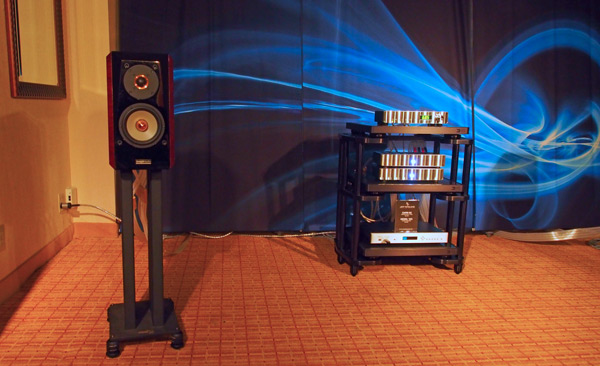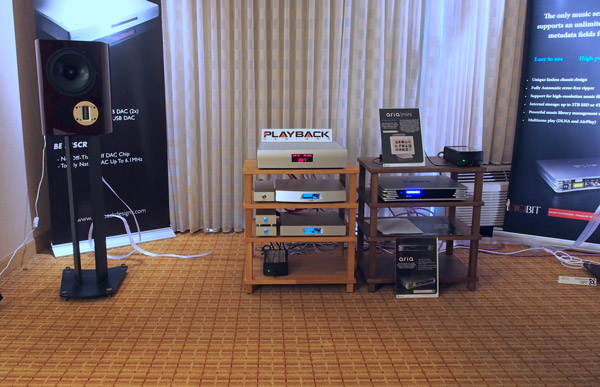| Columns Retired Columns & Blogs |
I don't think this was the premier of the Gamut RS5. Jason's report from T.H.E. 2014 mentions them, and I could have sworn I saw them at the Brooklyn show.


The Gamut R-series speakers use proprietary ScanSpeak drivers, including a wood-fiber–cone woofer and the high-performance ring-radiator tweeter. With the speakers driven by Gamut amplifiers and a prototype DAC/CD player ($13,995), which upsamples the data but dispenses with the usual digital reconstruction filter in favor of a low-slope analog filter, I listened to several recordings in this room, including the classic Gary Karr performance of the Albinoni Adagio on double bass. The system produced a very open sound with clean highs and a smooth, uncolored balance.

One of my best sounds at this year's RMAF was produced in the Jeff Rowland Design Group room, where a pair of Joseph Audio Pulsar standmounts ($7700/pair) were driven by a JRDG Capri S2 preamp with the DAC card ($4440), fed data from a Bryston BDP-2, and a pair of JRDG Model 125 amplifiers ($2950 each) in bridged mono mode. Cables were all Nordost. A Ladysmith Black Mambazo recording was reproduced with scarily tangible imaging. As much as I liked the more expensive Perspective, which I reviewed in the July 2014 issue, the Pulsar occupies the sweet spot in the Joseph Audio line.

The large Blanca Peak room on the Marriott's mezzanine floor featured a cost-no-object system put together by Denver retailer Apex Audio. Focal's Grande Utopia EM speakers ($195,000/pair) were driven by Soulution 701 monoblocks ($155,000/pair), a Soulution 725 preamp ($55,000), a Soulution 750 phono preamp ($25,000), and a Soulution 746 CD/SACD player ($95,000), with all the wiring from Tara Labs and racks from Critical Mass Systems. LPs were spun on a Transrotor Orion Reference table ($30,000) fitted with a Graham Phantom Elite tonearm ($12,000) fitted with an Air Tight PC-1 Supreme cartridge ($11,000). The sound was superb, as it should be given the system price, but was overall too mellow—it tamed a Black Keys LP—with a rather underdamped bass, the latter most likely due to the room acoustics, despite the use of Tube Traps in the room corners. (I had a similar experience in the same room at the 2013 show.)

Another Apex room on the mezzanine featured a system put together by distributor Musical Surroundings. Speakers again were from Focal, this time the Stella Utopia Ems ($97,500/pair), driven by Aesthetix Atlas monoblocks ($16,000/pair), the new Aesthetix Metis preamplifier ($20,000), and an Aesthetix Romulus Signature DSD-capable DAC/CD player ($10,000), all hooked up with Nordost Valhalla 2 cabling. A CD of Copland's Fanfare for the Common Man was reproduced with enormous dynamics and a smooth, uncolored balance and I have to say that I thought that this was the better-sounding of the two Apex rooms.

Here's a glamor shot of the Aesthetix Metis preamp, which is styled very differently from previous Aesthetix components.

Room 465 in the Marriott's atrium areas was next door to my sleeping room, but as this floor was part of Herb Reichert's beat, it wasn't until Sunday morning that I went into to take a listen. Source Systems and Pro Audio were showing a system based on Apertura Kayla speakers ($13,000/pair) driven by a Playback Designs IPS3 DSD-capable D/A integrated amplifier, with source either an Aria Audio Server/Ripper ($7999) or the new Aria-Mini Server ($3000–$5000, depending on options). Cables were all Nordost. The Aria is multichannel-capable, and will be reviewed by Kalman Rubinson in a future issue.